Sustainable Systems: Heliostat Bearing Design and Operation Report
VerifiedAdded on 2023/01/10
|15
|2795
|45
Report
AI Summary
This report presents a comprehensive analysis of heliostat bearing design and operation within sustainable systems. It begins with an introduction to heliostats and their applications in solar thermal power plants, including examples like PS10 in Spain and Odeillo in France. The report then delves into the selection of bearing diameter, considering factors like maintenance, longevity, and power loss. Calculations are performed to determine the appropriate dimensions based on the Sommerfeld Number and load conditions. The report further explores pressure, forces, and bearing diameter selection, considering both horizontal and inclined positions of the heliostat. PV and maximum specific wear rate are calculated, leading to the selection of tin-base babbit as the bearing material based on multi-criteria analysis. Friction torque is determined, and the design is optimized to minimize it while ensuring a 25-year lifespan. Finally, a proposed monitoring and prevention system using various sensors, including those for dust, current, humidity, and light, is discussed to ensure the system's reliability and performance.

1
Design and Operation of Sustainable Systems
Name
Class (Course)
Professor (Tutor)
School (University)
The City and State
The Date
Design and Operation of Sustainable Systems
Name
Class (Course)
Professor (Tutor)
School (University)
The City and State
The Date
Paraphrase This Document
Need a fresh take? Get an instant paraphrase of this document with our AI Paraphraser

2
1. Introduction
A heliostat is a gadget that incorporates a mirror, that changes position in order to
continue reflecting daylight towards a foreordained tower, making up for the evident
movements of the sun. The tower might be far from the heliostat.
In a sun powered thermal power plants such as the Spain’s PS10 and California’s
Solar One, a large area containing heliostats centers the energy of the sun on a tower
to warm fluid. The fluid is passed through a heat exchanger for steam generation and
after that create power through a steam turbine. According to Farges, Berzian and El
Haffi (2008), PS10 sunlight based focal recipient office works in Spain. It produces
11MW utilizing its 624120 square meters heliostats pointed at the 115m high pinnacle
Figure 1: PS10 Spain. Source, (Farges, Berzian and El Haffi, 2008)
A somehow distinctive course of action of heliostats in a field is utilized at
exploratory sun based heaters, for example, there is one in France, Odeillo. All
mirrors of the heliostat mirrors disseminates precisely parallel sunlight rays to a
substantial parabolic reflector that conveys the rays to an exact core interest (Guillot,
Rodriguez, Boullet, and Sans 2018.
1. Introduction
A heliostat is a gadget that incorporates a mirror, that changes position in order to
continue reflecting daylight towards a foreordained tower, making up for the evident
movements of the sun. The tower might be far from the heliostat.
In a sun powered thermal power plants such as the Spain’s PS10 and California’s
Solar One, a large area containing heliostats centers the energy of the sun on a tower
to warm fluid. The fluid is passed through a heat exchanger for steam generation and
after that create power through a steam turbine. According to Farges, Berzian and El
Haffi (2008), PS10 sunlight based focal recipient office works in Spain. It produces
11MW utilizing its 624120 square meters heliostats pointed at the 115m high pinnacle
Figure 1: PS10 Spain. Source, (Farges, Berzian and El Haffi, 2008)
A somehow distinctive course of action of heliostats in a field is utilized at
exploratory sun based heaters, for example, there is one in France, Odeillo. All
mirrors of the heliostat mirrors disseminates precisely parallel sunlight rays to a
substantial parabolic reflector that conveys the rays to an exact core interest (Guillot,
Rodriguez, Boullet, and Sans 2018.
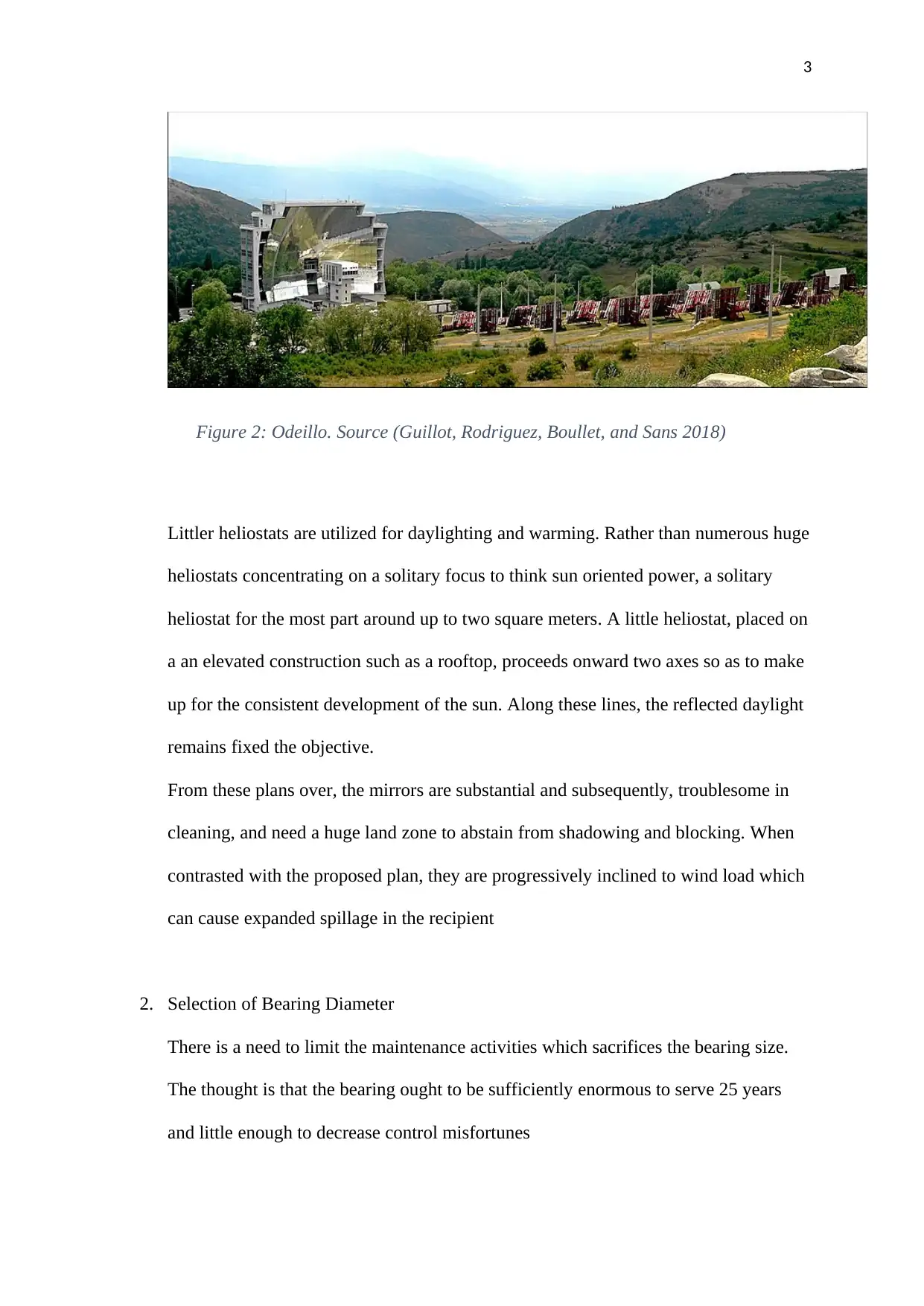
3
Figure 2: Odeillo. Source (Guillot, Rodriguez, Boullet, and Sans 2018)
Littler heliostats are utilized for daylighting and warming. Rather than numerous huge
heliostats concentrating on a solitary focus to think sun oriented power, a solitary
heliostat for the most part around up to two square meters. A little heliostat, placed on
a an elevated construction such as a rooftop, proceeds onward two axes so as to make
up for the consistent development of the sun. Along these lines, the reflected daylight
remains fixed the objective.
From these plans over, the mirrors are substantial and subsequently, troublesome in
cleaning, and need a huge land zone to abstain from shadowing and blocking. When
contrasted with the proposed plan, they are progressively inclined to wind load which
can cause expanded spillage in the recipient
2. Selection of Bearing Diameter
There is a need to limit the maintenance activities which sacrifices the bearing size.
The thought is that the bearing ought to be sufficiently enormous to serve 25 years
and little enough to decrease control misfortunes
Figure 2: Odeillo. Source (Guillot, Rodriguez, Boullet, and Sans 2018)
Littler heliostats are utilized for daylighting and warming. Rather than numerous huge
heliostats concentrating on a solitary focus to think sun oriented power, a solitary
heliostat for the most part around up to two square meters. A little heliostat, placed on
a an elevated construction such as a rooftop, proceeds onward two axes so as to make
up for the consistent development of the sun. Along these lines, the reflected daylight
remains fixed the objective.
From these plans over, the mirrors are substantial and subsequently, troublesome in
cleaning, and need a huge land zone to abstain from shadowing and blocking. When
contrasted with the proposed plan, they are progressively inclined to wind load which
can cause expanded spillage in the recipient
2. Selection of Bearing Diameter
There is a need to limit the maintenance activities which sacrifices the bearing size.
The thought is that the bearing ought to be sufficiently enormous to serve 25 years
and little enough to decrease control misfortunes
⊘ This is a preview!⊘
Do you want full access?
Subscribe today to unlock all pages.

Trusted by 1+ million students worldwide

4
For a general industrial machinery, the proportion of length to diameter (l/d) is
between a scope of 1-2. In the plan of journal bearing, there is a broad utilization of
dimensionless parameters - the Sommerfeld Number (Illner, Bartel, and Deters 2015)
Sommerfeld Number = ZN
P ( d
c )
2
For a majority of designs, the Sommerfeld Number is
14.3 ×106 = ZN
P ( d
c )
2
P= W/ld = (300×9.81)/ld
N is approximated to be 20 rpm for the heliostat
From the table, c/d = 0.001 and therefore, d/c = 1000
Z = 0.03
Therefore,
14.3 ×106 =0.0 3 ×20 × ld
300 ×9.81 (1000)2
Therefore, ld = 70141.5mm2
But l/d = 2, hence, l =2d
Therefore
d = 187.271mm, say 188 mm
Length equals 2(188) = 376 mm
3. Pressure, forces, and selecting the diameter of bearing
From the abovementioned, we have two qualities for the measurement. It is
appropriate to choose the one which meets the cost necessities. Taking into account
For a general industrial machinery, the proportion of length to diameter (l/d) is
between a scope of 1-2. In the plan of journal bearing, there is a broad utilization of
dimensionless parameters - the Sommerfeld Number (Illner, Bartel, and Deters 2015)
Sommerfeld Number = ZN
P ( d
c )
2
For a majority of designs, the Sommerfeld Number is
14.3 ×106 = ZN
P ( d
c )
2
P= W/ld = (300×9.81)/ld
N is approximated to be 20 rpm for the heliostat
From the table, c/d = 0.001 and therefore, d/c = 1000
Z = 0.03
Therefore,
14.3 ×106 =0.0 3 ×20 × ld
300 ×9.81 (1000)2
Therefore, ld = 70141.5mm2
But l/d = 2, hence, l =2d
Therefore
d = 187.271mm, say 188 mm
Length equals 2(188) = 376 mm
3. Pressure, forces, and selecting the diameter of bearing
From the abovementioned, we have two qualities for the measurement. It is
appropriate to choose the one which meets the cost necessities. Taking into account
Paraphrase This Document
Need a fresh take? Get an instant paraphrase of this document with our AI Paraphraser

5
that the l/d proportion for such a machine is somewhere in the range of 1 to 2, 188mm
and also meets the Sommerfeld Number criteria
The weight acting normally for the provided load can be computed as shown below,
w=mg=300× 9.81=2943 N
This is the force acting on the heliostat at completely horizontal or vertical position.
When, say the device is inclined at an angle of 60 degrees, the force can be resolved
as shown.
Horizontal force = wcos60= 2943cos60 =1471.5N
Vertical force = wsin60 = 2943sin60 = 2548.71N
The tangential force = mv2/r = 300
V = 2π×20/60 = 2.09 rad/s
Therefore, centrifugal force = 13999.43N
Pressure on the bearing is given by
P = W/LD = 2943/ (376×188) = 0.041633N/mm2
Or P = 41633.657N/m2
4. PV and maximum specific wear rate & material
v = k ∙ W ∙ L
where
v = volume of material which has been worn out (m3),
L = total sliding distance (m).
W = normal applied load (N),
that the l/d proportion for such a machine is somewhere in the range of 1 to 2, 188mm
and also meets the Sommerfeld Number criteria
The weight acting normally for the provided load can be computed as shown below,
w=mg=300× 9.81=2943 N
This is the force acting on the heliostat at completely horizontal or vertical position.
When, say the device is inclined at an angle of 60 degrees, the force can be resolved
as shown.
Horizontal force = wcos60= 2943cos60 =1471.5N
Vertical force = wsin60 = 2943sin60 = 2548.71N
The tangential force = mv2/r = 300
V = 2π×20/60 = 2.09 rad/s
Therefore, centrifugal force = 13999.43N
Pressure on the bearing is given by
P = W/LD = 2943/ (376×188) = 0.041633N/mm2
Or P = 41633.657N/m2
4. PV and maximum specific wear rate & material
v = k ∙ W ∙ L
where
v = volume of material which has been worn out (m3),
L = total sliding distance (m).
W = normal applied load (N),
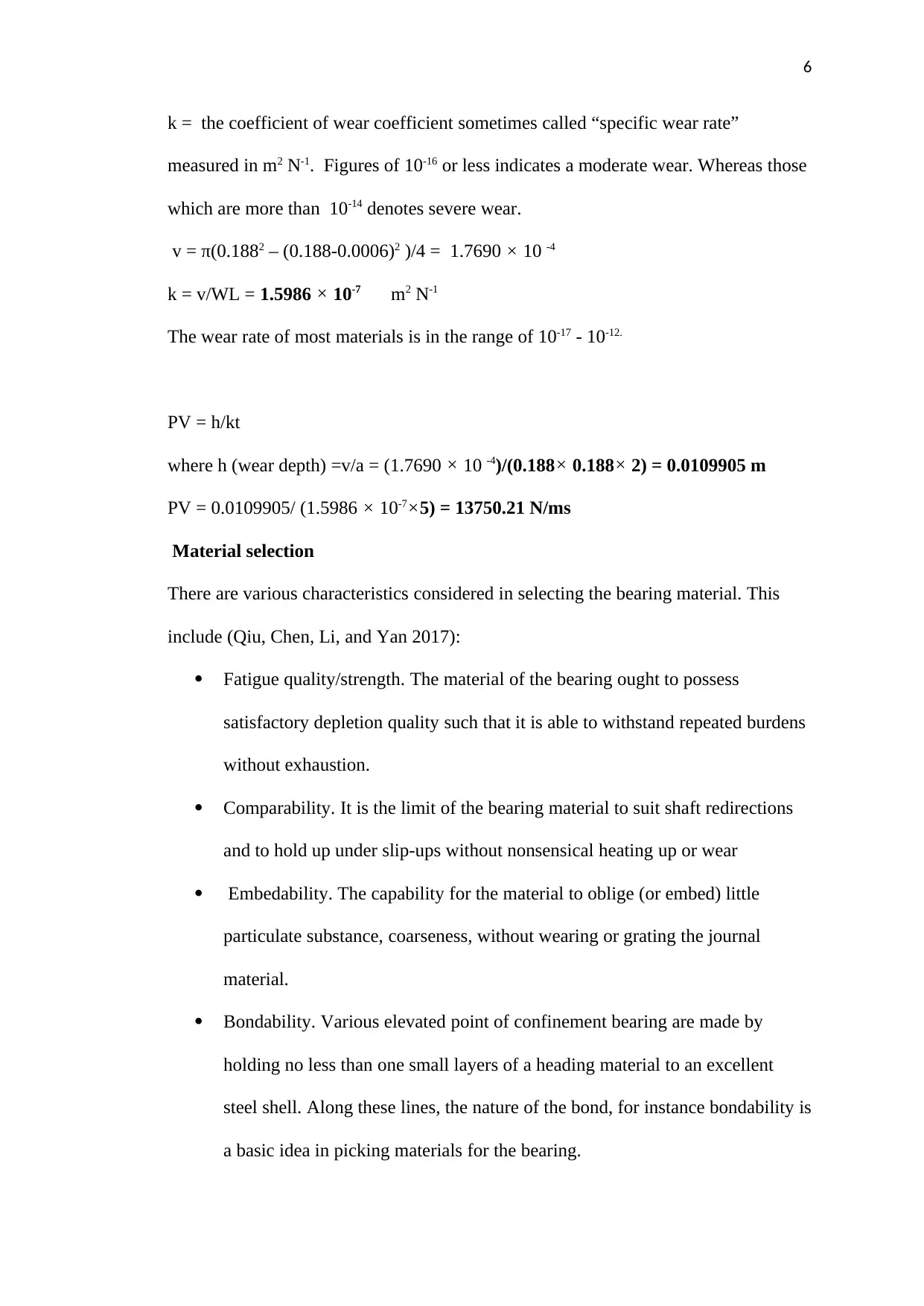
6
k = the coefficient of wear coefficient sometimes called “specific wear rate”
measured in m2 N-1. Figures of 10-16 or less indicates a moderate wear. Whereas those
which are more than 10-14 denotes severe wear.
v = π(0.1882 – (0.188-0.0006)2 )/4 = 1.7690 × 10 -4
k = v/WL = 1.5986 × 10-7 m2 N-1
The wear rate of most materials is in the range of 10-17 - 10-12.
PV = h/kt
where h (wear depth) =v/a = (1.7690 × 10 -4)/(0.188× 0.188× 2) = 0.0109905 m
PV = 0.0109905/ (1.5986 × 10-7×5) = 13750.21 N/ms
Material selection
There are various characteristics considered in selecting the bearing material. This
include (Qiu, Chen, Li, and Yan 2017):
Fatigue quality/strength. The material of the bearing ought to possess
satisfactory depletion quality such that it is able to withstand repeated burdens
without exhaustion.
Comparability. It is the limit of the bearing material to suit shaft redirections
and to hold up under slip-ups without nonsensical heating up or wear
Embedability. The capability for the material to oblige (or embed) little
particulate substance, coarseness, without wearing or grating the journal
material.
Bondability. Various elevated point of confinement bearing are made by
holding no less than one small layers of a heading material to an excellent
steel shell. Along these lines, the nature of the bond, for instance bondability is
a basic idea in picking materials for the bearing.
k = the coefficient of wear coefficient sometimes called “specific wear rate”
measured in m2 N-1. Figures of 10-16 or less indicates a moderate wear. Whereas those
which are more than 10-14 denotes severe wear.
v = π(0.1882 – (0.188-0.0006)2 )/4 = 1.7690 × 10 -4
k = v/WL = 1.5986 × 10-7 m2 N-1
The wear rate of most materials is in the range of 10-17 - 10-12.
PV = h/kt
where h (wear depth) =v/a = (1.7690 × 10 -4)/(0.188× 0.188× 2) = 0.0109905 m
PV = 0.0109905/ (1.5986 × 10-7×5) = 13750.21 N/ms
Material selection
There are various characteristics considered in selecting the bearing material. This
include (Qiu, Chen, Li, and Yan 2017):
Fatigue quality/strength. The material of the bearing ought to possess
satisfactory depletion quality such that it is able to withstand repeated burdens
without exhaustion.
Comparability. It is the limit of the bearing material to suit shaft redirections
and to hold up under slip-ups without nonsensical heating up or wear
Embedability. The capability for the material to oblige (or embed) little
particulate substance, coarseness, without wearing or grating the journal
material.
Bondability. Various elevated point of confinement bearing are made by
holding no less than one small layers of a heading material to an excellent
steel shell. Along these lines, the nature of the bond, for instance bondability is
a basic idea in picking materials for the bearing.
⊘ This is a preview!⊘
Do you want full access?
Subscribe today to unlock all pages.

Trusted by 1+ million students worldwide
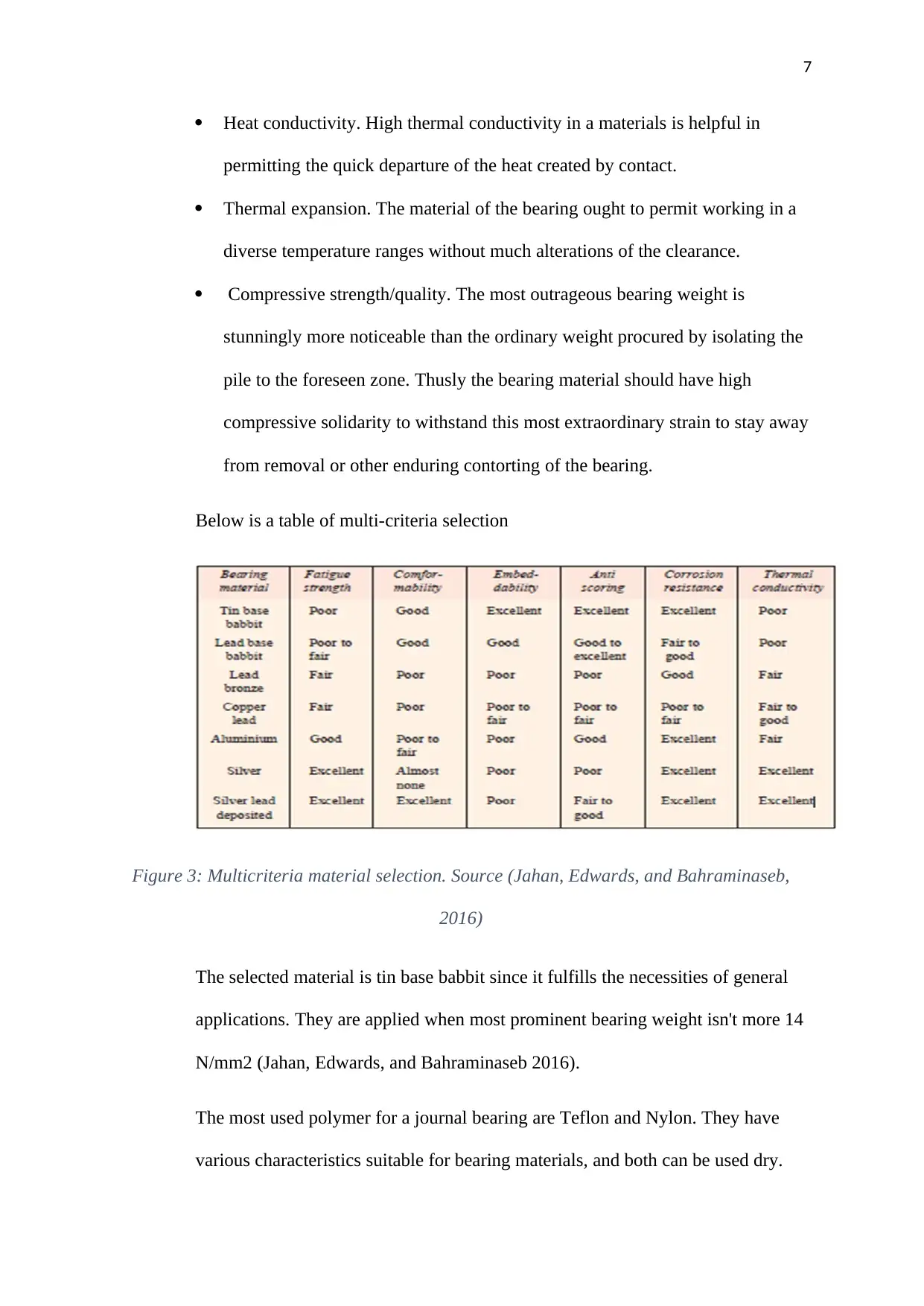
7
Heat conductivity. High thermal conductivity in a materials is helpful in
permitting the quick departure of the heat created by contact.
Thermal expansion. The material of the bearing ought to permit working in a
diverse temperature ranges without much alterations of the clearance.
Compressive strength/quality. The most outrageous bearing weight is
stunningly more noticeable than the ordinary weight procured by isolating the
pile to the foreseen zone. Thusly the bearing material should have high
compressive solidarity to withstand this most extraordinary strain to stay away
from removal or other enduring contorting of the bearing.
Below is a table of multi-criteria selection
Figure 3: Multicriteria material selection. Source (Jahan, Edwards, and Bahraminaseb,
2016)
The selected material is tin base babbit since it fulfills the necessities of general
applications. They are applied when most prominent bearing weight isn't more 14
N/mm2 (Jahan, Edwards, and Bahraminaseb 2016).
The most used polymer for a journal bearing are Teflon and Nylon. They have
various characteristics suitable for bearing materials, and both can be used dry.
Heat conductivity. High thermal conductivity in a materials is helpful in
permitting the quick departure of the heat created by contact.
Thermal expansion. The material of the bearing ought to permit working in a
diverse temperature ranges without much alterations of the clearance.
Compressive strength/quality. The most outrageous bearing weight is
stunningly more noticeable than the ordinary weight procured by isolating the
pile to the foreseen zone. Thusly the bearing material should have high
compressive solidarity to withstand this most extraordinary strain to stay away
from removal or other enduring contorting of the bearing.
Below is a table of multi-criteria selection
Figure 3: Multicriteria material selection. Source (Jahan, Edwards, and Bahraminaseb,
2016)
The selected material is tin base babbit since it fulfills the necessities of general
applications. They are applied when most prominent bearing weight isn't more 14
N/mm2 (Jahan, Edwards, and Bahraminaseb 2016).
The most used polymer for a journal bearing are Teflon and Nylon. They have
various characteristics suitable for bearing materials, and both can be used dry.
Paraphrase This Document
Need a fresh take? Get an instant paraphrase of this document with our AI Paraphraser
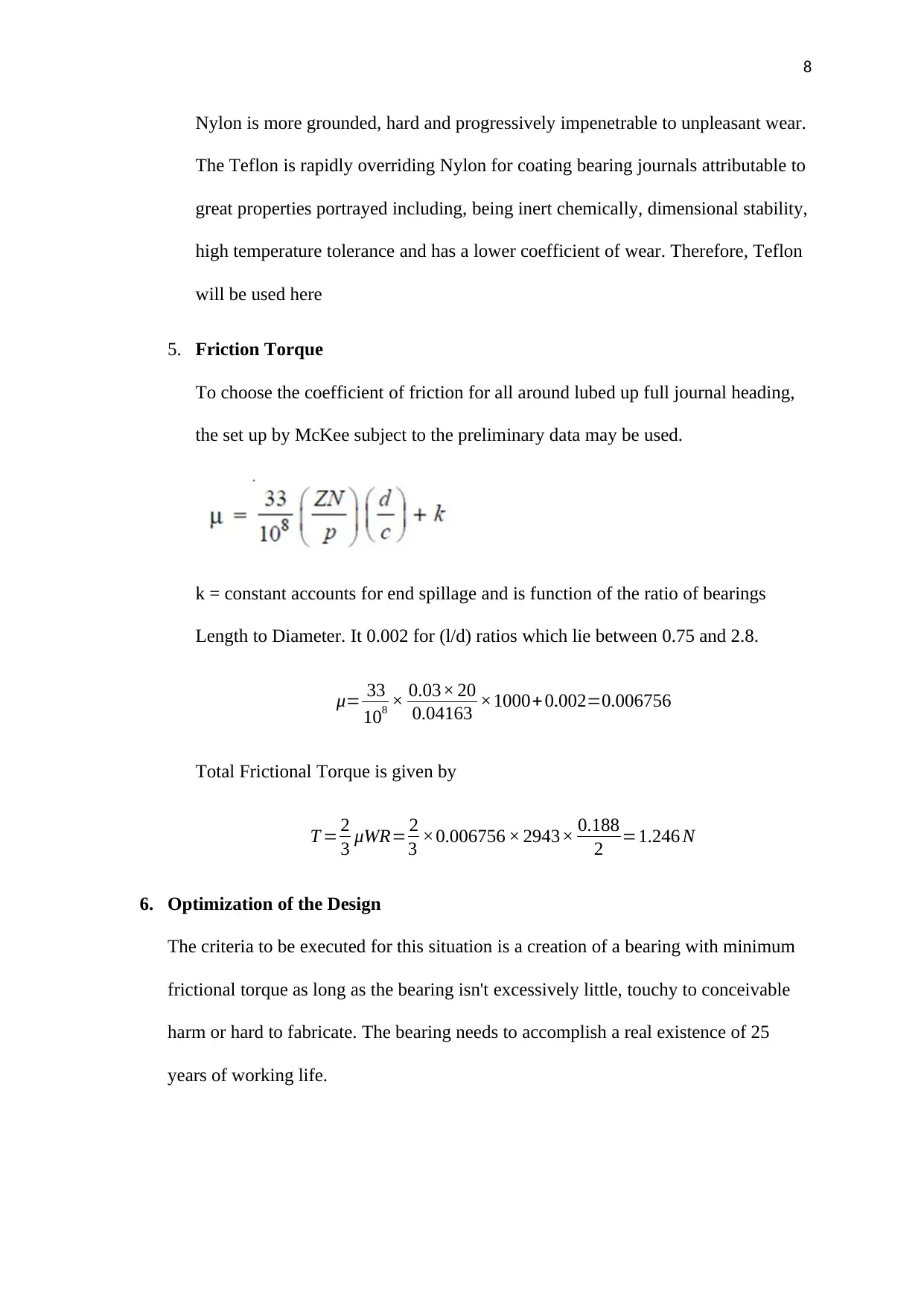
8
Nylon is more grounded, hard and progressively impenetrable to unpleasant wear.
The Teflon is rapidly overriding Nylon for coating bearing journals attributable to
great properties portrayed including, being inert chemically, dimensional stability,
high temperature tolerance and has a lower coefficient of wear. Therefore, Teflon
will be used here
5. Friction Torque
To choose the coefficient of friction for all around lubed up full journal heading,
the set up by McKee subject to the preliminary data may be used.
k = constant accounts for end spillage and is function of the ratio of bearings
Length to Diameter. It 0.002 for (l/d) ratios which lie between 0.75 and 2.8.
μ= 33
108 × 0.03× 20
0.04163 ×1000+ 0.002=0.006756
Total Frictional Torque is given by
T = 2
3 μWR= 2
3 ×0.006756 × 2943× 0.188
2 =1.246 N
6. Optimization of the Design
The criteria to be executed for this situation is a creation of a bearing with minimum
frictional torque as long as the bearing isn't excessively little, touchy to conceivable
harm or hard to fabricate. The bearing needs to accomplish a real existence of 25
years of working life.
Nylon is more grounded, hard and progressively impenetrable to unpleasant wear.
The Teflon is rapidly overriding Nylon for coating bearing journals attributable to
great properties portrayed including, being inert chemically, dimensional stability,
high temperature tolerance and has a lower coefficient of wear. Therefore, Teflon
will be used here
5. Friction Torque
To choose the coefficient of friction for all around lubed up full journal heading,
the set up by McKee subject to the preliminary data may be used.
k = constant accounts for end spillage and is function of the ratio of bearings
Length to Diameter. It 0.002 for (l/d) ratios which lie between 0.75 and 2.8.
μ= 33
108 × 0.03× 20
0.04163 ×1000+ 0.002=0.006756
Total Frictional Torque is given by
T = 2
3 μWR= 2
3 ×0.006756 × 2943× 0.188
2 =1.246 N
6. Optimization of the Design
The criteria to be executed for this situation is a creation of a bearing with minimum
frictional torque as long as the bearing isn't excessively little, touchy to conceivable
harm or hard to fabricate. The bearing needs to accomplish a real existence of 25
years of working life.

9
25 years = 25×365×24 = 219,000 hours. Accepting that the heliostats alter position
thrice in an hour and each adjustment takes 8 seconds, the all-out time = 219,000×3×8
= 657, 000 seconds
Assume the heliostat rotates 90O in 8 second, thus average angular velocity,
ω = 90 x (2π)/(360×8) rad/s = 0.1963 rad/s
Remember that: wear volume, Q = kWL or k=Q/(WL)
Q = area of thrust area x maximum wear depth
= [π(188/2)2 - π(187.4/2)2 ] x 0.6 mm3 = π 33.786 mm3
= 106.1 mm3 = 1.061 x 10-5 m3
Load = 300kg = 2943 N
Thus required k = 1.061 x 10-6 /(2943 x L) m3N-1m-1
= (3.06 / L) x 10-9 m2N-1
Every time the heliostat rotates through 90O, the sliding distance is ( π x30x90/360)
mm = 2.356 x 10-2 m
Thus total sliding distance, L = 657,000 x 2.356 x 10-2 m = 15480.19 m
Hence required k = (3.06/15480 ) x 10-9 m2N-1= 1.976 x 10-13 m2N-1
25 years = 25×365×24 = 219,000 hours. Accepting that the heliostats alter position
thrice in an hour and each adjustment takes 8 seconds, the all-out time = 219,000×3×8
= 657, 000 seconds
Assume the heliostat rotates 90O in 8 second, thus average angular velocity,
ω = 90 x (2π)/(360×8) rad/s = 0.1963 rad/s
Remember that: wear volume, Q = kWL or k=Q/(WL)
Q = area of thrust area x maximum wear depth
= [π(188/2)2 - π(187.4/2)2 ] x 0.6 mm3 = π 33.786 mm3
= 106.1 mm3 = 1.061 x 10-5 m3
Load = 300kg = 2943 N
Thus required k = 1.061 x 10-6 /(2943 x L) m3N-1m-1
= (3.06 / L) x 10-9 m2N-1
Every time the heliostat rotates through 90O, the sliding distance is ( π x30x90/360)
mm = 2.356 x 10-2 m
Thus total sliding distance, L = 657,000 x 2.356 x 10-2 m = 15480.19 m
Hence required k = (3.06/15480 ) x 10-9 m2N-1= 1.976 x 10-13 m2N-1
⊘ This is a preview!⊘
Do you want full access?
Subscribe today to unlock all pages.

Trusted by 1+ million students worldwide
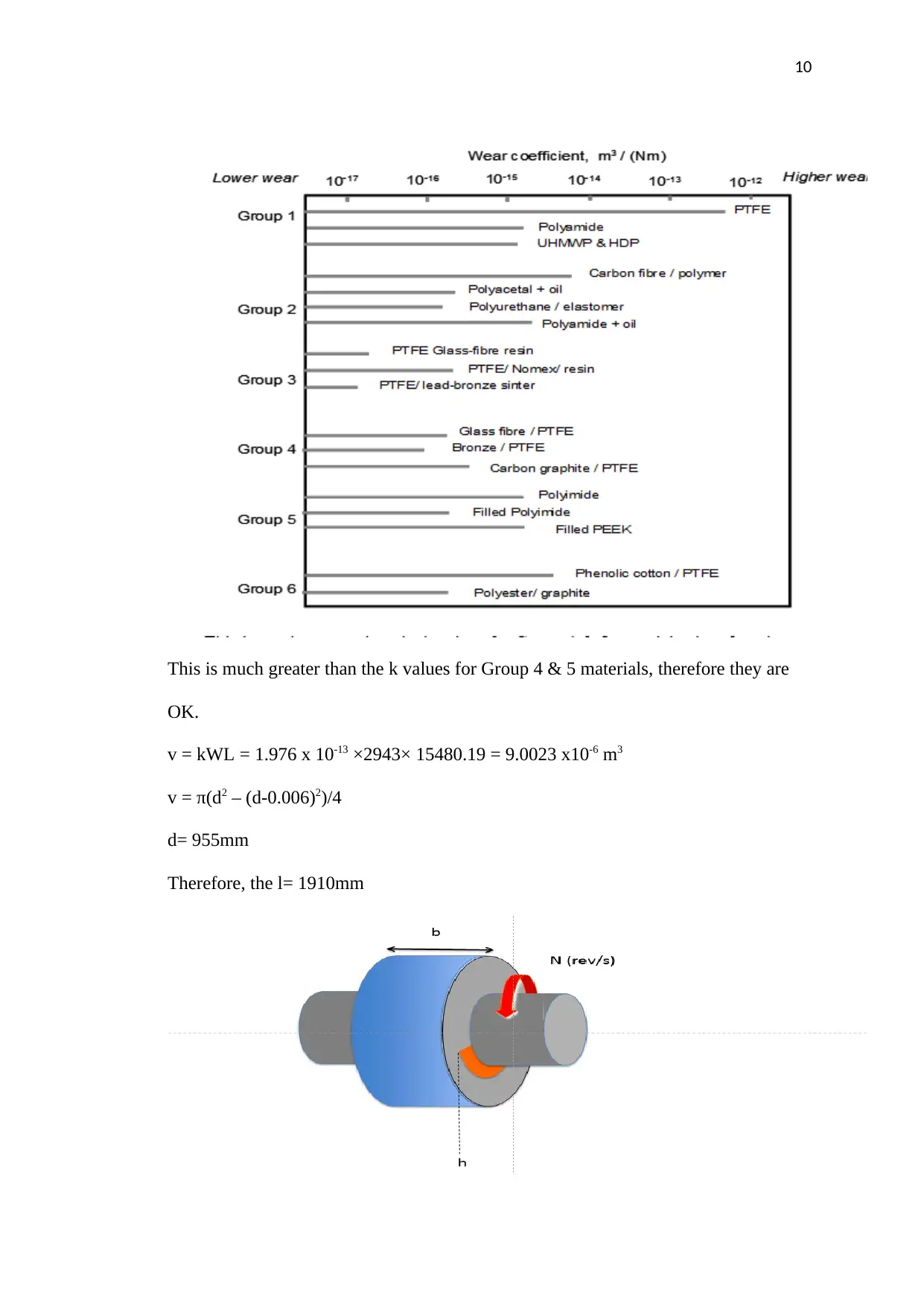
10
This is much greater than the k values for Group 4 & 5 materials, therefore they are
OK.
v = kWL = 1.976 x 10-13 ×2943× 15480.19 = 9.0023 x10-6 m3
v = π(d2 – (d-0.006)2)/4
d= 955mm
Therefore, the l= 1910mm
This is much greater than the k values for Group 4 & 5 materials, therefore they are
OK.
v = kWL = 1.976 x 10-13 ×2943× 15480.19 = 9.0023 x10-6 m3
v = π(d2 – (d-0.006)2)/4
d= 955mm
Therefore, the l= 1910mm
Paraphrase This Document
Need a fresh take? Get an instant paraphrase of this document with our AI Paraphraser
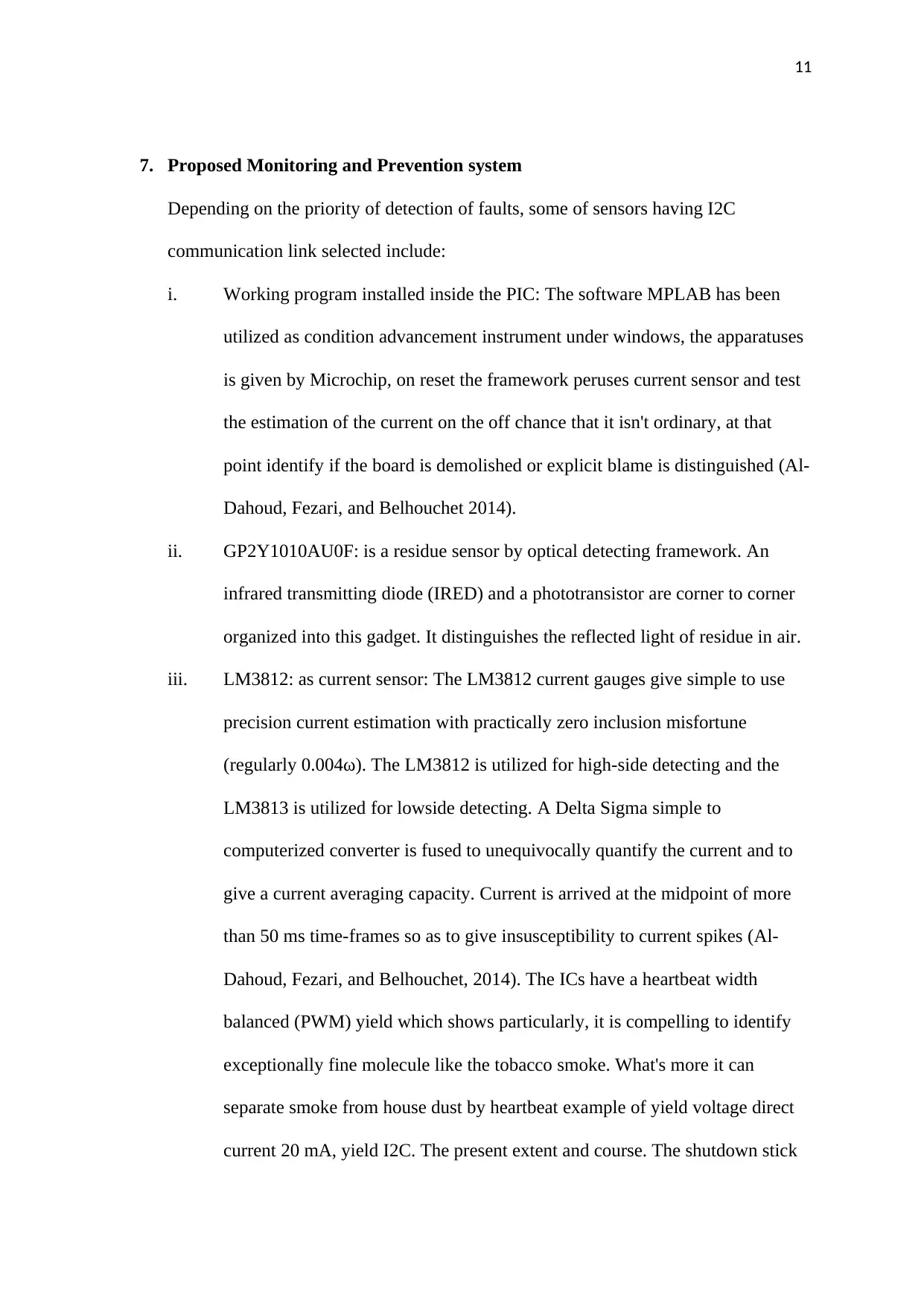
11
7. Proposed Monitoring and Prevention system
Depending on the priority of detection of faults, some of sensors having I2C
communication link selected include:
i. Working program installed inside the PIC: The software MPLAB has been
utilized as condition advancement instrument under windows, the apparatuses
is given by Microchip, on reset the framework peruses current sensor and test
the estimation of the current on the off chance that it isn't ordinary, at that
point identify if the board is demolished or explicit blame is distinguished (Al-
Dahoud, Fezari, and Belhouchet 2014).
ii. GP2Y1010AU0F: is a residue sensor by optical detecting framework. An
infrared transmitting diode (IRED) and a phototransistor are corner to corner
organized into this gadget. It distinguishes the reflected light of residue in air.
iii. LM3812: as current sensor: The LM3812 current gauges give simple to use
precision current estimation with practically zero inclusion misfortune
(regularly 0.004ω). The LM3812 is utilized for high-side detecting and the
LM3813 is utilized for lowside detecting. A Delta Sigma simple to
computerized converter is fused to unequivocally quantify the current and to
give a current averaging capacity. Current is arrived at the midpoint of more
than 50 ms time-frames so as to give insusceptibility to current spikes (Al-
Dahoud, Fezari, and Belhouchet, 2014). The ICs have a heartbeat width
balanced (PWM) yield which shows particularly, it is compelling to identify
exceptionally fine molecule like the tobacco smoke. What's more it can
separate smoke from house dust by heartbeat example of yield voltage direct
current 20 mA, yield I2C. The present extent and course. The shutdown stick
7. Proposed Monitoring and Prevention system
Depending on the priority of detection of faults, some of sensors having I2C
communication link selected include:
i. Working program installed inside the PIC: The software MPLAB has been
utilized as condition advancement instrument under windows, the apparatuses
is given by Microchip, on reset the framework peruses current sensor and test
the estimation of the current on the off chance that it isn't ordinary, at that
point identify if the board is demolished or explicit blame is distinguished (Al-
Dahoud, Fezari, and Belhouchet 2014).
ii. GP2Y1010AU0F: is a residue sensor by optical detecting framework. An
infrared transmitting diode (IRED) and a phototransistor are corner to corner
organized into this gadget. It distinguishes the reflected light of residue in air.
iii. LM3812: as current sensor: The LM3812 current gauges give simple to use
precision current estimation with practically zero inclusion misfortune
(regularly 0.004ω). The LM3812 is utilized for high-side detecting and the
LM3813 is utilized for lowside detecting. A Delta Sigma simple to
computerized converter is fused to unequivocally quantify the current and to
give a current averaging capacity. Current is arrived at the midpoint of more
than 50 ms time-frames so as to give insusceptibility to current spikes (Al-
Dahoud, Fezari, and Belhouchet, 2014). The ICs have a heartbeat width
balanced (PWM) yield which shows particularly, it is compelling to identify
exceptionally fine molecule like the tobacco smoke. What's more it can
separate smoke from house dust by heartbeat example of yield voltage direct
current 20 mA, yield I2C. The present extent and course. The shutdown stick

12
can be utilized to restrain false activating amid start-up, or to enter a low quiet
current mode.
iv. SHT21 as dampness sensor: The amazingly little SHT21 advanced mugginess
and temperature sensor coordinates sensors, alignment memory and
computerized interface on 3 x 3 mm impression. Also the mugginess sensor
gives electronic read-out of following data. The total over-embellishment of
the sensor chip - except for the moistness sensor zone - ensures the completely
aligned and reflow mugginess and temperature sensor against outer effect and
prompts a superb dependability against maturing, stun and unpredictable
synthetic substances. Yield: I²C advanced, PWM, SDM/simple Volt, interface,
RH working reach: and RH reaction time: 8 sec (63%).
v. SFH5712: as light sensor, high exactness I2C interface and low power
utilization and low affectability to temperature coefficient. The SFH 5712
recognizes surrounding splendor similarly as the human eye, and offers the I²C
standard information rates as well as fast rates of up to 3.4 MHz. Without the
requirement for any extra control directions, an incorporated circuit in the
sensor naturally gives a deliberate value two times per second (Al-Dahoud,
Fezari, and Belhouchet 2014). The sensor has just four associations and
occupies almost no room. It can without much of a stretch convey through its
coordinated I²C interface. No simple circuit components are required. With
150 μA amid task and just 1.5 μA in remain by mode, the sensor expends very
little power.
vi. LM3812/LM3813 Current Gauges give simple to use precision current
estimation with practically zero inclusion misfortune (regularly 0.004ω). The
can be utilized to restrain false activating amid start-up, or to enter a low quiet
current mode.
iv. SHT21 as dampness sensor: The amazingly little SHT21 advanced mugginess
and temperature sensor coordinates sensors, alignment memory and
computerized interface on 3 x 3 mm impression. Also the mugginess sensor
gives electronic read-out of following data. The total over-embellishment of
the sensor chip - except for the moistness sensor zone - ensures the completely
aligned and reflow mugginess and temperature sensor against outer effect and
prompts a superb dependability against maturing, stun and unpredictable
synthetic substances. Yield: I²C advanced, PWM, SDM/simple Volt, interface,
RH working reach: and RH reaction time: 8 sec (63%).
v. SFH5712: as light sensor, high exactness I2C interface and low power
utilization and low affectability to temperature coefficient. The SFH 5712
recognizes surrounding splendor similarly as the human eye, and offers the I²C
standard information rates as well as fast rates of up to 3.4 MHz. Without the
requirement for any extra control directions, an incorporated circuit in the
sensor naturally gives a deliberate value two times per second (Al-Dahoud,
Fezari, and Belhouchet 2014). The sensor has just four associations and
occupies almost no room. It can without much of a stretch convey through its
coordinated I²C interface. No simple circuit components are required. With
150 μA amid task and just 1.5 μA in remain by mode, the sensor expends very
little power.
vi. LM3812/LM3813 Current Gauges give simple to use precision current
estimation with practically zero inclusion misfortune (regularly 0.004ω). The
⊘ This is a preview!⊘
Do you want full access?
Subscribe today to unlock all pages.

Trusted by 1+ million students worldwide
1 out of 15
Related Documents
Your All-in-One AI-Powered Toolkit for Academic Success.
+13062052269
info@desklib.com
Available 24*7 on WhatsApp / Email
![[object Object]](/_next/static/media/star-bottom.7253800d.svg)
Unlock your academic potential
Copyright © 2020–2025 A2Z Services. All Rights Reserved. Developed and managed by ZUCOL.



